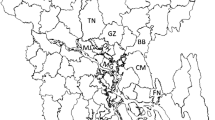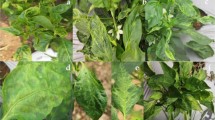Abstract
Natural occurrence of mosaic disease was observed on basil (Ocimum sanctum L.) in Aligarh, U. P., India, during 2008. The disease could be transmitted by sap inoculations from naturally infected O. sanctum to O. sanctum and some test plant species. Cucumber mosaic virus (CMV) was detected by RT-PCR using coat protein gene specific primers of CMV (Acc. AM180922 & AM180923), which resulted in the expected size ~650 bp amplicon in infected samples. The amplicon was cloned, sequenced and data were deposited in GenBank Acc. EU600216. The sequence data analysis revealed 97–99% identities at both nucleotide and amino acid levels with the CMV strains of subgroup II reported worldwide. Based on the high sequence identities and close phylogenetic relationships with CMV subgroup II strains, the virus under study has been identified as a new isolate of CMV subgroup II and designated as CMV-Basil.


Similar content being viewed by others
References
Davino, S., Accotto, G. P., Masenga, V., Torta, L., & Davino, M. (2008). Basil (Ocimum basilicum), a new host of Pepino mosaic virus. New Disease Reports, 18, 21.
Feldman, J. M., & Garcia, O. (1970). Two new natural hosts of alfalfa mosaic virus. Plant Disease, 54, 722–723.
Francki, R. I. B., Mossop, D. W., & Hatta, T. (1979). Cucumber mosaic virus. CMI/AAB Descriptions of Plant Viruses, 213, 6.
Holcomb, G. E., Valverde, R. A., Sim, J., & Nuss, J. (1999). First report on natural occurrence of tomato spotted wilt tospovirus in basil (Ocimum basilicum). Plant Disease, 8, 966.
Kumar, S., Srivastava, A., & Raj, S. K. (2005). Molecular detection of Cucumber mosaic virus in chrysanthemum cultivars. Acta Phytopathologica et Entomologica Hungarica, 40, 205–211.
Marini, E. (1955). Una virosi apparsa sul basilica (Ocimum basilicum). Rivista dell Ortoflorofrutticultura Italiana, 39, 360–362.
Noordam, D. (1973). Identification of plant viruses—methods and experiments. Wageningen, the Netherlands: Center for Agricultural Publishing and Documentation.
Palukaitis, P., & Garcia-Arenal, F. (2003). Cucumoviruses. Advances in Virus Research, 62, 241–323.
Pratap, D., Kumar, S., & Raj, S. K. (2008). First molecular identification of a Cucumber mosaic virus isolate associated with shoestring symptom on tomato in India. Australasian Plant Disease Notes, 3, 57–58.
Raj, S. K., Chandra, G., & Singh, B. P. (1997). Some Indian strains of Cucumber mosaic virus lacking satellite RNA. Indian Journal of Experimental Biology, 35, 1128–1131.
Samad, A., Ajay Kumar, P. V., Gupta, M. K., Shukla, A. K., Darokar, M. P., Somkuwar, B., et al. (2008). Natural infection of periwinkle (Catharanthus roseus), with Cucumber mosaic virus subgroup Ib. Australasian Plant Disease Notes, 3, 30–34.
Sanz, N. T., Chen, T. H., & Lai, P. Y. (2001). A newly discovered mosaic disease of bush basil in Taiwan. Plant Pathology Bulletin, 10, 155–164.
Srivastava, A., & Raj, S. K. (2004). High molecular similarity among Indian isolates of Cucumber mosaic virus suggests a common origin. Current Science, 87, 1126–1131.
Sudhakar, H., Prasad, D. N., Mohan, N., & Murugesan, K. (2006). First report of CMV subgroup II infecting Lycopersicon esculentum in India. Plant Disease, 90, 1457.
Verma, N., Mahinghara, V. K., Ram, R., & Zaidi, A. A. (2006). Coat protein sequence shows that Cucumber mosaic virus isolate from geranium (Pelargonium spp.) belongs to subgroup II. Journal of Biosciences, 31, 47–54.
Acknowledgments
The authors are thankful to the Director of the National Botanical Research Institute, Lucknow, India, for providing facilities for our research, and to the Council of Scientific and Industrial Research (CSIR), New Delhi, India, for a fellowship to S. Kumar.
Author information
Authors and Affiliations
Corresponding author
Rights and permissions
About this article
Cite this article
Khan, A.A., Sharma, R., Afreen, B. et al. Molecular identification of a new isolate of Cucumber mosaic virus subgroup II from basil (Ocimum sanctum) in India. Phytoparasitica 39, 199–203 (2011). https://doi.org/10.1007/s12600-011-0146-8
Received:
Accepted:
Published:
Issue Date:
DOI: https://doi.org/10.1007/s12600-011-0146-8




